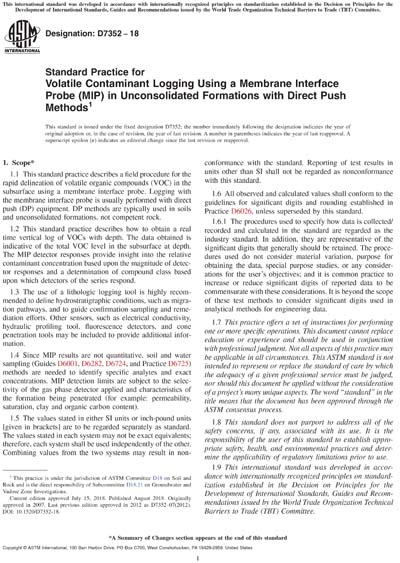Most recent
ASTM D7352-18
Standard Practice for Volatile Contaminant Logging Using a Membrane Interface Probe (MIP) in Unconsolidated Formations with Direct Push Methods
1.1 This standard practice describes a field procedure for the rapid delineation of volatile organic compounds (VOC) in the subsurface using a membrane interface probe. Logging with the membrane interface probe is usually performed with direct push (DP) equipment. DP methods are typically used in soils and unconsolidated formations, not competent rock.
1.2 This standard practice describes how to obtain a real time vertical log of VOCs with depth. The data obtained is indicative of the total VOC level in the subsurface at depth. The MIP detector responses provide insight into the relative contaminant concentration based upon the magnitude of detector responses and a determination of compound class based upon which detectors of the series respond.
1.3 The use of a lithologic logging tool is highly recommended to define hydrostratigraphic conditions, such as migration pathways, and to guide confirmation sampling and remediation efforts. Other sensors, such as electrical conductivity, hydraulic profiling tool, fluorescence detectors, and cone penetration tools may be included to provide additional information.
1.4 Since MIP results are not quantitative, soil and water sampling (Guides D6001, D6282, D6724, and Practice D6725) methods are needed to identify specific analytes and exact concentrations. MIP detection limits are subject to the selectivity of the gas phase detector applied and characteristics of the formation being penetrated (for example: permeability, saturation, clay and organic carbon content).
1.5 The values stated in either SI units or inch-pound units [given in brackets] are to be regarded separately as standard. The values stated in each system may not be exact equivalents; therefore, each system shall be used independently of the other. Combining values from the two systems may result in non-conformance with the standard. Reporting of test results in units other than SI shall not be regarded as nonconformance with this standard.
1.6 All observed and calculated values shall conform to the guidelines for significant digits and rounding established in Practice D6026, unless superseded by this standard.
1.6.1 The procedures used to specify how data is collected/recorded and calculated in the standard are regarded as the industry standard. In addition, they are representative of the significant digits that generally should be retained. The procedures used do not consider material variation, purpose for obtaining the data, special purpose studies, or any considerations for the user’s objectives; and it is common practice to increase or reduce significant digits of reported data to be commensurate with these considerations. It is beyond the scope of these test methods to consider significant digits used in analytical methods for engineering data.
1.7 This practice offers a set of instructions for performing one or more specific operations. This document cannot replace education or experience and should be used in conjunction with professional judgment. Not all aspects of this practice may be applicable in all circumstances. This ASTM standard is not intended to represent or replace the standard of care by which the adequacy of a given professional service must be judged, nor should this document be applied without the consideration of a project’s many unique aspects. The word “standard” in the title means that the document has been approved through the ASTM consensus process.
1.8 This standard does not purport to address all of the safety concerns, if any, associated with its use. It is the responsibility of the user of this standard to establish appropriate safety, health, and environmental practices and determine the applicability of regulatory limitations prior to use.
1.9 This international standard was developed in accordance with internationally recognized principles on standardization established in the Decision on Principles for the Development of International Standards, Guides and Recommendations issued by the World Trade Organization Technical Barriers to Trade (TBT) Committee.
Content Provider
ASTM International [astm]






